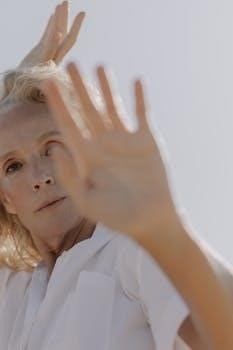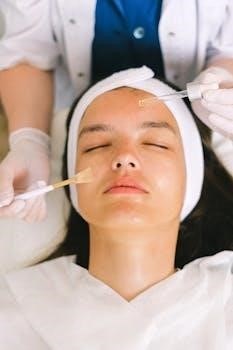Facial palsy exercises are crucial for stimulating facial nerves, restoring muscle strength, and improving coordination. These exercises, often part of physical therapy, aim to enhance facial symmetry and accelerate recovery from conditions like Bell’s palsy.
Understanding Facial Palsy
Facial palsy, often manifesting as Bell’s palsy, involves weakness or paralysis of facial muscles due to nerve inflammation or damage. This condition disrupts the brain-to-nerve communication, leading to difficulties in controlling facial movements. It can affect one side of the face, impacting expressions, eye closure, and mouth movement. The inflammation of the facial nerve is a common cause, and understanding this nerve’s role is crucial for effective rehabilitation. This paralysis can be temporary, but targeted exercises are essential to regain normal function. Early intervention through physical therapy and facial exercises are key to promoting recovery and minimizing lasting effects. Facial palsy varies in severity, necessitating personalized treatment plans.

Benefits of Facial Exercises
Facial exercises offer numerous benefits, including improved muscle strength, enhanced facial symmetry, and faster recovery from facial palsy. These exercises also promote better nerve function and coordination.
Improved Muscle Strength
Facial exercises are designed to specifically target weakened muscles affected by facial palsy, aiding in the gradual restoration of their strength. These exercises promote muscle activation and contraction, leading to increased muscle tone and functionality. Regular, consistent practice of these exercises helps to rebuild the strength of the facial muscles, which are essential for various expressions and functions. By repeatedly performing specific movements, individuals can enhance the ability of their facial muscles to contract with more force and control. This increased strength allows for better control over facial movements, improving overall facial function and reducing the impact of muscle weakness that comes with facial paralysis. The exercises stimulate muscle fibers, contributing to their overall health and vitality.
Enhanced Facial Symmetry
Facial exercises play a vital role in improving facial symmetry, which is often disrupted by facial palsy. By strengthening the weakened muscles on the affected side, these exercises help to balance the facial features and minimize the appearance of asymmetry. The exercises focus on engaging specific muscles to restore a more even and balanced look to the face. Consistent practice helps to reduce drooping and unevenness, improving the overall aesthetic symmetry. Through targeted movements and muscle engagement, these exercises help to counteract the effects of paralysis, working towards a more symmetrical and natural appearance. Over time, consistent exercises contribute to a more balanced facial presentation, boosting confidence and self-esteem.
Faster Recovery
Engaging in regular facial exercises can significantly contribute to a faster recovery from facial palsy. These exercises work by stimulating the facial nerves and muscles, promoting nerve regeneration and muscle function. By actively working the facial muscles, these exercises help to counteract the effects of paralysis, facilitating quicker restoration of movement and control. Consistent, gentle exercises can prevent muscle atrophy and improve circulation, which are key factors in the healing process. The exercises help to re-establish the brain-to-muscle connection, which is essential for regaining normal facial movement. Thus, facial exercises play an important role in accelerating the recovery timeline and improving outcomes.

Types of Facial Exercises
Facial exercises for palsy are diverse, focusing on different areas. These include eye exercises, mouth and lip exercises, and forehead and cheek exercises, each designed to target specific muscle groups.
Eye Exercises
Eye exercises are essential for individuals with facial palsy, as the condition can impact eyelid control and tear production. These exercises aim to improve muscle strength around the eyes and ensure proper closure, which is vital for protecting the eye from dryness and injury. Specific movements, such as gently raising the eyebrows, frowning, and attempting to close the affected eye, are often recommended. These movements should be performed slowly and deliberately, avoiding any forceful actions. Consistency is key, and these exercises should be done regularly to help restore normal eye function. It is also helpful to wear glasses or goggles to protect the eyes from dust and dirt.
Mouth and Lip Exercises
Mouth and lip exercises are vital for regaining control over facial muscles affected by palsy. These exercises target muscles used for speaking, eating, and expressing emotions. Common exercises include gently smiling, pursing the lips, and making various mouth shapes. Another useful exercise involves grasping the center of the lips with the thumb and index finger, then gently pushing inwards. It’s crucial to perform these exercises with slow, controlled movements, avoiding any forceful or exaggerated actions. Regular practice helps improve muscle strength, mobility, and coordination, making everyday activities easier. Consistent exercise is key for optimal recovery.
Forehead and Cheek Exercises
Forehead and cheek exercises are essential for targeting specific facial muscles affected by palsy. These exercises aim to improve muscle strength and coordination in these areas, enhancing facial expressions. Forehead exercises include gently raising eyebrows, frowning, and wrinkling the forehead. Cheek exercises might involve puffing out the cheeks, gently pulling the corners of the mouth back, and small circular massages. It is important to perform these exercises slowly and gently, ensuring not to cause fatigue. Regular practice of these movements can improve muscle control and help regain symmetrical facial expressions, promoting recovery.

Performing Exercises Correctly
Correct execution of facial exercises involves gentle movements, avoiding forced or exaggerated motions. It’s crucial to prevent muscle fatigue, ensuring a low effort level, and maintaining small, controlled actions during each repetition.
Gentle Movements
When performing facial palsy exercises, it is paramount to prioritize gentle movements. Avoid any forceful or exaggerated actions that could potentially strain the delicate facial muscles. The focus should be on controlled, small motions rather than large, sweeping gestures. This approach ensures that the exercises are rehabilitative and not harmful. Starting with minimal effort allows the muscles to gradually regain strength and coordination. It is crucial to listen to your body and stop if you feel any pain. Progress should be incremental, respecting the current state of your facial muscles and nerves. The aim is to facilitate healing and not to cause further stress or discomfort. Remember, consistency and gentle practice are keys to successful recovery.
Avoiding Fatigue
During facial palsy exercises, it is essential to avoid muscle fatigue. Overexertion can hinder progress and potentially cause setbacks in your recovery. The goal is to stimulate the muscles, not exhaust them. If you begin to feel a light tiredness, that’s a good point to take a break. Pushing beyond this can lead to muscle exhaustion, which is counterproductive. It’s better to perform shorter, more frequent exercise sessions than one long, strenuous one. Rest is also crucial for muscle repair and nerve regeneration. By being mindful of your body’s limits, you create an environment conducive to healing. Consistent, gentle exercises are more effective than trying too hard too soon.
Role of Physical Therapy
Physical therapy plays a vital role in facial palsy recovery by providing professional guidance. Therapists design personalized exercise plans to improve muscle strength and coordination, optimizing outcomes for patients.
Professional Guidance
Seeking professional guidance from a physical therapist is essential for effective facial palsy rehabilitation. A qualified therapist can assess your specific condition and create a tailored exercise program to address your unique needs. They will teach you correct techniques for performing exercises, ensuring you are not causing further strain or injury. Furthermore, a physical therapist can monitor your progress and adjust your program as necessary, maximizing your recovery potential. They can also provide valuable advice on managing symptoms, such as pain or discomfort. The expertise of a physical therapist ensures that you are performing exercises correctly, consistently, and effectively for optimal results, supporting faster recovery and better overall outcomes. Their knowledge and support are invaluable during the recovery process.

Additional Therapies
Besides exercises, therapies like massage can help with facial palsy. Massage techniques can improve circulation, reduce muscle tension, and promote relaxation, complementing the benefits of exercises for recovery.
Massage Techniques
Massage techniques play a supportive role in facial palsy recovery, working alongside targeted exercises. Gentle facial massage can help improve blood circulation, which is essential for muscle repair and nerve regeneration. The application of light pressure can also help reduce muscle tension and discomfort associated with facial paralysis. Specific massage techniques, such as circular motions and light strokes, can be employed on the affected side of the face, including the forehead, cheeks, and lips. These techniques can promote relaxation and improve overall facial muscle flexibility. Furthermore, massage may help in preventing tooth decay by stimulating saliva production, which can be reduced due to facial palsy. It’s important to perform these massages gently, avoiding any forceful movements that could cause further strain or discomfort to the delicate facial muscles. Consistency in applying these techniques can enhance their effectiveness.
